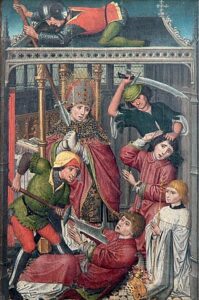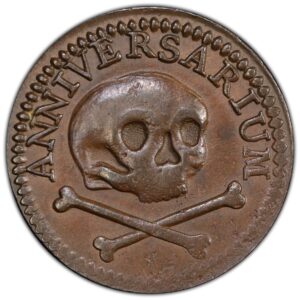
Rare Circa 1650 Saint Lambert’s Communion Token – “Memento Mori”
To learn more about the history of this rare token please see our article titled “An In-Depth Look Into Saint Lambert Communion Tokens”
Item #CC-0481 | Rare Circa 1650 Saint Lambert’s Communion Token – “Memento Mori”
Mint: Liège, Belgium
Ruler/Period: Maximilian Henry of Bavaria, the Prince Bishop of Liege (1621-1688)
Grade: PCGS MS-62 Brown
For details on this coin from PCGS, click on the serial number here: https://www.pcgs.com/cert/48145768
Description: This beautiful and rare “Memento Mori” communion token was used in the late 17th century through the 18th century. It was often given to people before they took communion and to commemorate the martyrdom of Saint Lambert of Liège. These tokens were also handed out to people at feasts and funerals. The legend on the obverse reads “ANNIVERSAR” which is Latin for “The Anniversary” and the legend on the reverse reads “ECCLESI LEODI” which stands for “The Church of Liège“. Some believe “The Anniversary” is meant to commemorate the death of Saint Lambert. This coin is one of five varieties that display a skull and crossbones design and is catalogued in the 1948 edition of The Numismatist “Charity Tokens of The Netherlands” by O.P. Eklund as coin #86.
History of Saint Lambert
 Lambert of Maastricht, commonly referred to as Saint Lambert (c. 636 A.D. – c. 705 A.D.) was the bishop of Maastricht-Liège from about 670 A.D. until his death. The death of Saint Lambert is believed to have been the result of him admonishing the Merovingian Duke Pepin II (Pepin of Herstal) for infidelity with a noblewoman named Alpaida. This illicit union was responsible for the birth of Charles Martel (“The Hammer” 688 – 741) and Childebrand I (678–751). (Childebrand I later became Pepin’s successor, uniting all the Frankish kingdoms and becoming the first King of the Franks.) Naturally, this public humiliation and admonishment were frowned upon by Pepin and Alpaida, and they had St. Lambert and two of his relatives murdered (c.705 – 709 A.D.).
Lambert of Maastricht, commonly referred to as Saint Lambert (c. 636 A.D. – c. 705 A.D.) was the bishop of Maastricht-Liège from about 670 A.D. until his death. The death of Saint Lambert is believed to have been the result of him admonishing the Merovingian Duke Pepin II (Pepin of Herstal) for infidelity with a noblewoman named Alpaida. This illicit union was responsible for the birth of Charles Martel (“The Hammer” 688 – 741) and Childebrand I (678–751). (Childebrand I later became Pepin’s successor, uniting all the Frankish kingdoms and becoming the first King of the Franks.) Naturally, this public humiliation and admonishment were frowned upon by Pepin and Alpaida, and they had St. Lambert and two of his relatives murdered (c.705 – 709 A.D.).
While few details of St. Lambert’s life are known, historians and religious scholars have agreed that he was “stabbed with a javelin” during mass in Liege’s Chapel of Saints Cosmas & Damian for “criticizing … the Pepin of Heristal for his adultery”. St. Lambert is celebrated as a martyr and patron saint, having defended the fidelity of marriage and not succumbing to Merovingian politics. For more information on Saint Lambert, visit: https://en.wikipedia.org/wiki/Lambert_of_Maastricht
Memento Mori “Remember death”
In early Christianity, the expression “memento mori” developed with the growth of Christianity, which emphasized divine judgement, heaven, hell, and the salvation of the soul in the afterlife. Memento mori is a Latin phrase, which literally means “Remember death” or “Remember that you die“. The 2nd-century Christian writer Tertullian claimed in his Apologeticus, that during a triumphal procession, a victorious general had someone standing behind him, holding a crown over his head and whispering: “Respice post te. Hominem te esse memento. Memento mori.” Which means “Look after yourself. Remember you’re a man. Remember you will die.”
To the Christian, the prospect of death serves to emphasize the emptiness and fleetingness of earthly pleasures, luxuries, and achievements, and thus also as an invitation to focus one’s thoughts on the prospect of the afterlife. This finds ritual expression in the rites of Ash Wednesday, when ashes are placed upon the worshipers’ foreheads with the words, “Remember man that you are dust and unto dust, you shall return.”
 Memento mori is an artistic or symbolic metaphor that serves as a reminder of the inevitability of death and the eternal nature of the human spirit. The most common motif is a skull accompanied by one or more bones. The ‘skull and cross bones’ can be seen on some Roman and early Christian tombs, the Knights Templar used it around the 13th century and pirates used it during the Golden Age of Piracy on their flags known as the “Jolly Roger”.
Memento mori is an artistic or symbolic metaphor that serves as a reminder of the inevitability of death and the eternal nature of the human spirit. The most common motif is a skull accompanied by one or more bones. The ‘skull and cross bones’ can be seen on some Roman and early Christian tombs, the Knights Templar used it around the 13th century and pirates used it during the Golden Age of Piracy on their flags known as the “Jolly Roger”.
The memento mori image used on the Jolly Roger was used during the early 1700’s by a number of pirate captains, including Black Sam Bellamy, Edward England, and John Taylor. It became the most commonly used pirate flag during the 1720s. Richard Hawkins, who was captured by pirates in 1724, reported that the pirates had a black flag bearing the figure of a skeleton stabbing a heart with a spear, which they named “Jolly Roger”. This description closely resembles the flags of a number of Golden Age pirates.
For more information on the Jolly Roger, visit: https://en.wikipedia.org/wiki/Jolly_Roger
For more information on the history of Saint Lambert Communion Tokens, see our article titled “An In-Depth Look Into Saint Lambert Communion Tokens at https://commodorecoins.com/2023/11/an-in-depth-look-into-saint-lamberts-communion-tokens/

